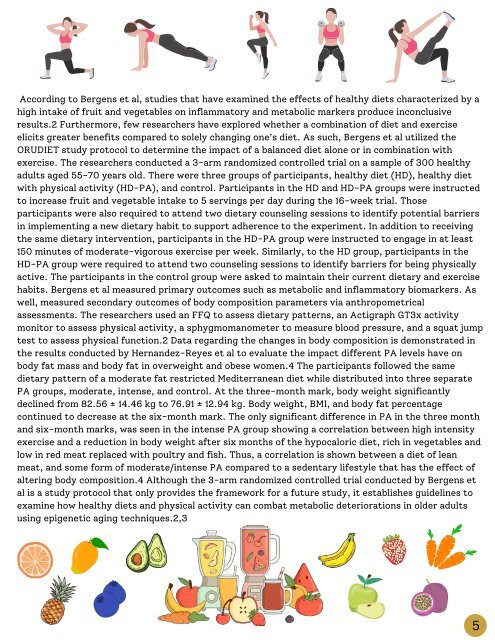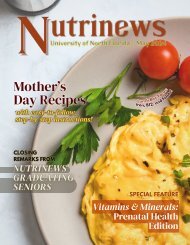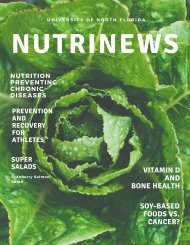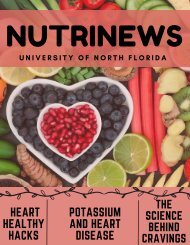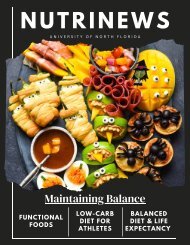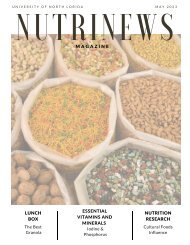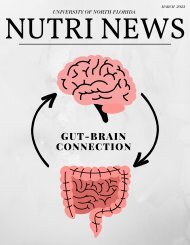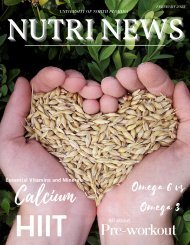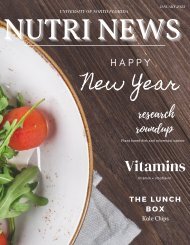January 2024
As the new year begins, many are implementing resolutions. Therefore, this months issue focuses on nutrition resolutions. Creating resolutions that are reachable, attainable, and measurable is extremely important for consistency and lasting lifestyle changes.
As the new year begins, many are implementing resolutions. Therefore, this months issue focuses on nutrition resolutions. Creating resolutions that are reachable, attainable, and measurable is extremely important for consistency and lasting lifestyle changes.
Create successful ePaper yourself
Turn your PDF publications into a flip-book with our unique Google optimized e-Paper software.
According to Bergens et al, studies that have examined the effects of healthy diets characterized by a<br />
high intake of fruit and vegetables on inflammatory and metabolic markers produce inconclusive<br />
results.2 Furthermore, few researchers have explored whether a combination of diet and exercise<br />
elicits greater benefits compared to solely changing one’s diet. As such, Bergens et al utilized the<br />
ORUDIET study protocol to determine the impact of a balanced diet alone or in combination with<br />
exercise. The researchers conducted a 3-arm randomized controlled trial on a sample of 300 healthy<br />
adults aged 55-70 years old. There were three groups of participants, healthy diet (HD), healthy diet<br />
with physical activity (HD-PA), and control. Participants in the HD and HD-PA groups were instructed<br />
to increase fruit and vegetable intake to 5 servings per day during the 16-week trial. Those<br />
participants were also required to attend two dietary counseling sessions to identify potential barriers<br />
in implementing a new dietary habit to support adherence to the experiment. In addition to receiving<br />
the same dietary intervention, participants in the HD-PA group were instructed to engage in at least<br />
150 minutes of moderate-vigorous exercise per week. Similarly, to the HD group, participants in the<br />
HD-PA group were required to attend two counseling sessions to identify barriers for being physically<br />
active. The participants in the control group were asked to maintain their current dietary and exercise<br />
habits. Bergens et al measured primary outcomes such as metabolic and inflammatory biomarkers. As<br />
well, measured secondary outcomes of body composition parameters via anthropometrical<br />
assessments. The researchers used an FFQ to assess dietary patterns, an Actigraph GT3x activity<br />
monitor to assess physical activity, a sphygmomanometer to measure blood pressure, and a squat jump<br />
test to assess physical function.2 Data regarding the changes in body composition is demonstrated in<br />
the results conducted by Hernandez-Reyes et al to evaluate the impact different PA levels have on<br />
body fat mass and body fat in overweight and obese women.4 The participants followed the same<br />
dietary pattern of a moderate fat restricted Mediterranean diet while distributed into three separate<br />
PA groups, moderate, intense, and control. At the three-month mark, body weight significantly<br />
declined from 82.56 ± 14.46 kg to 76.91 ± 12.94 kg. Body weight, BMI, and body fat percentage<br />
continued to decrease at the six-month mark. The only significant difference in PA in the three month<br />
and six-month marks, was seen in the intense PA group showing a correlation between high intensity<br />
exercise and a reduction in body weight after six months of the hypocaloric diet, rich in vegetables and<br />
low in red meat replaced with poultry and fish. Thus, a correlation is shown between a diet of lean<br />
meat, and some form of moderate/intense PA compared to a sedentary lifestyle that has the effect of<br />
altering body composition.4 Although the 3-arm randomized controlled trial conducted by Bergens et<br />
al is a study protocol that only provides the framework for a future study, it establishes guidelines to<br />
examine how healthy diets and physical activity can combat metabolic deteriorations in older adults<br />
using epigenetic aging techniques.2,3<br />
5


